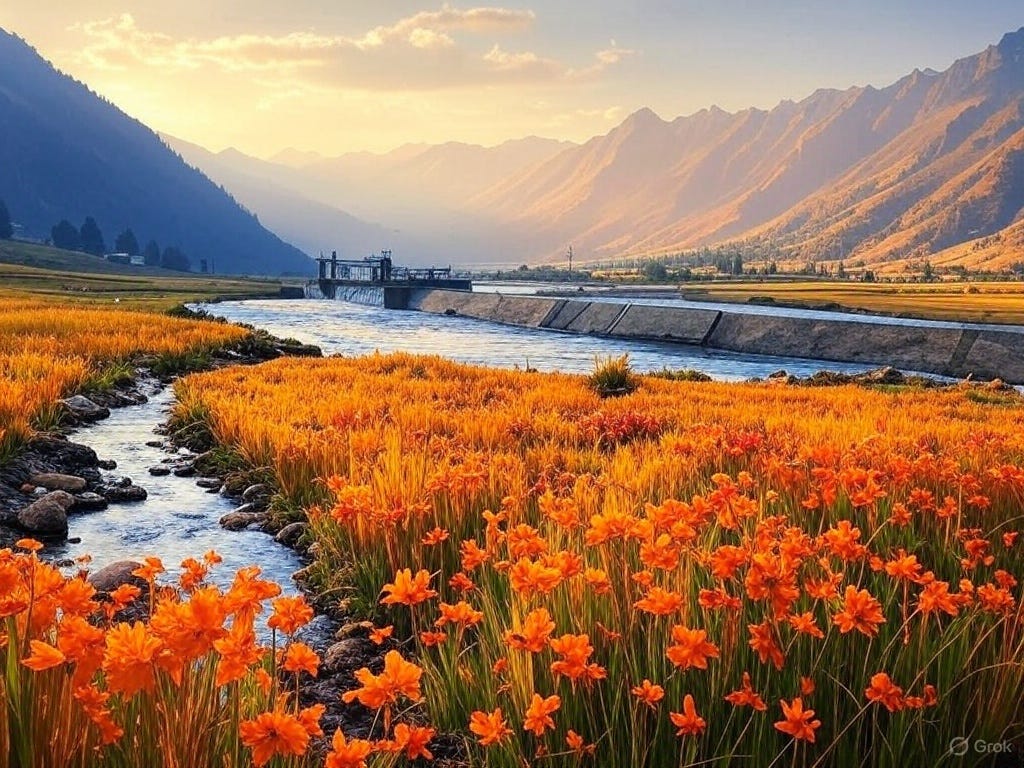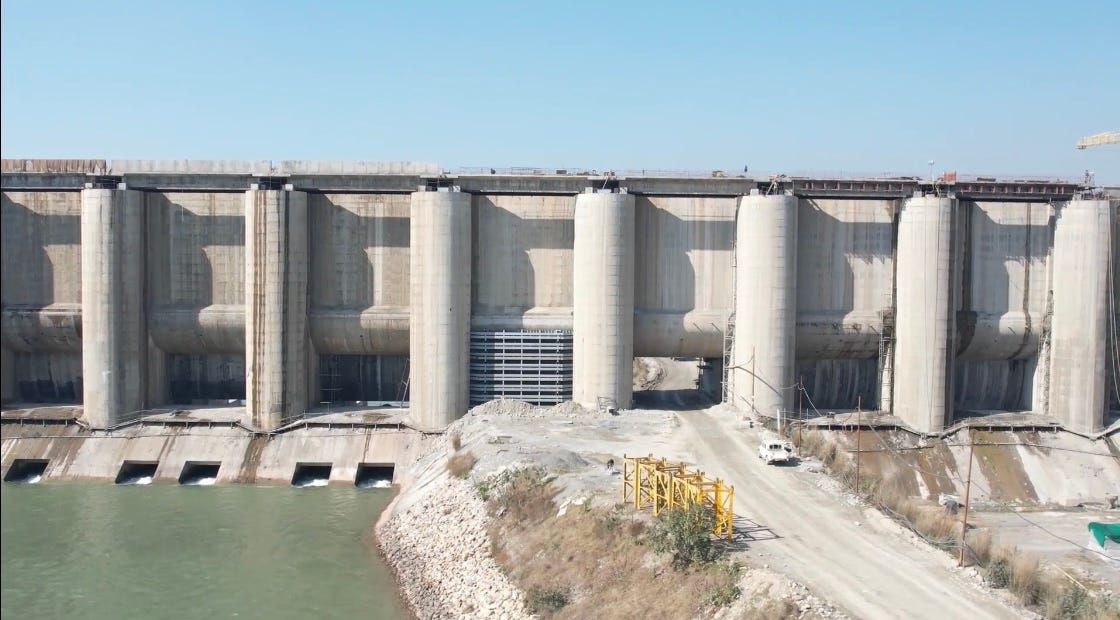Indus Waters Treaty: India has Hitherto Utilised Only a Small Fraction of what was its Entitlement
A full abrogation of IWT would be the assertion of its inalienable sovereign rights as upper-riparian state, sweeping away residual clauses that have long constrained control over its own rights.
Rights Negligibly Used—India’s Western-River Entitlements Still Under-tapped
1. Suspension Ushers in Unfettered Control—Yet Exposes Decades of Neglect
India’s 23 April 2025 move to suspend the Indus Waters Treaty, announced in the aftermath of the Pahalgam massacre, was met with relief and cautious optimism across the country—nowhere more so than in Punjab, Jammu & Kashmir, and among India’s broader community of water-resource specialists and riparian-rights advocates. For the first time since 1960, New Delhi can in principle draw upon the Indus, Jhelum and Chenab unfettered by the treaty’s procedural shackles, external vetoes, or the self-imposed constraints that have long blunted Indian ambition. Yet a sober review of the ledger reveals an uncomfortable truth: even under the old rules India made use of only a small fraction of the modest entitlements it already enjoyed. The suspension therefore shines a harsher light on decades of lost opportunity—opportunity that must now be seized if the policy shift is to move from symbolism to substance.
2. The Reservoir Gap—94% of Storage Still on Paper
Article III of the IWT permits India to impound 3.6 million acre-feet (MAF) on the western rivers—1.25 MAF for irrigation and domestic use, 1.60 MAF for hydropower pondage, and 0.75 MAF for flood moderation. Yet, in more than six decades, the country has built storage for barely 0.2 MAF, almost all of it the modest pondage at Baglihar on the Chenab. Not a single litre of general-purpose or flood-control storage exists in Ladakh or across the Pir Panjal. In effect, India has—by default rather than design—hitherto relinquished, if not permanently forfeited, seasonal water security for some 200,000 hectares of prospective command area and about 600 megawatts of firm evening-peak power.
3. Acreage Allowed, Acreage Ignored—A Record of Chronic Under-Utilisation
The Treaty also authorises India to irrigate 1.34 million acres in J & K and Ladakh. In reality, only 642 000 acres—just under half—receive assured canal water. The balance is rain-fed, leaving the valleys drought-prone and cropping choices severely constrained. In Ladakh, irrigation is limited to narrow green ribbons along the Indus and to a few glacier-fed channels; the vast khushk (dry) basins—lying in the Himalayan rain shadow and largely beyond the reach of the south-west monsoon—remain almost entirely uncultivated.
4. Power Potential Squandered—Salal Silted, Dams Deferred
Technical assessments place the hydropower potential of India’s stretches of the western rivers at roughly 18.6 GW, yet installed capacity struggles to reach 3.2 GW. On the Chenab alone, more than 8.8 GW still lies on the drawing board, while the Jhelum and upper Indus together represent another 5.5 GW of untapped clean energy. Even the routine desilting of the Salal Dam—a flagship hydro-station on the Chenab in Reasi district—has repeatedly stalled under frivolous objections raised by Pakistani authorities, eroding both storage and generation efficiency. Existing run-of-the-river schemes do supply power, but with minimal pondage they lack diurnal flexibility: they cannot reliably cover the evening peak or furnish the reactive reserves the northern grid increasingly demands.
5. The Missing Projects—Assets that should have been created
Had decision-making, and execution, been bolder, India would today command three big multipurpose reservoirs in Jammu and Kashmir:
Bursar on the Chenab, cleared in 2012, would have stored 1.2 MAF, generated 800 MW and supplied gravity irrigation to roughly 45 000 hectares in the Kargil–Dras valleys.
Sawalkot, discussed since the early 1990s, would have added 1.8 MAF and 1 856 MW while opening up another 60 000 hectares in the Chenab gorge of Kathua-Udhampur.
A Marhu diversion tunnel from the Chenab to the Ravi system could already be transferring about 2.5 MAF a year into Punjab’s canal grid, slashing tubewell dependence.
Add to these the solar-assisted Baramulla lift scheme and a full flood-plain agriculture plan on the Jhelum—together capable of irrigating another 30 000 hectares—plus the long-overdue desilting of Salal (which would restore 0.05 MAF of lost storage and recover or renew 160 MW of firm power). Had even Bursar and Sawalkot progressed on schedule, India would already enjoy 3 MAF of new storage and 2.7 GW of extra capacity.
6. The Ravi Conundrum—Progress Lost in Punjab vs J&K Litigation
On the Ravi, meant to trap India’s unfettered share of eastern waters, decades have slipped away in disputes and litigation. Ranjit Sagar (Thein) Dam, commissioned in 2000 after nineteen years of construction, is silting faster than expected and sheds generation every lean season. Downstream, Shahpur Kandi—sanctioned in 1995 to balance Ranjit Sagar releases and irrigate over 37 000 hectares in Punjab and J & K but actually allotted only in 2013—has spent twenty-eight years mired in cost-sharing squabbles; civil works executed by the Punjab Irrigation Department are now practically complete and the powerhouse is pledged for June 2025. Given the fresh enthusiasm sparked by the suspension of the IWT, one can only hope there are no further slippages.
Farther upstream, the Ujh Multipurpose Project (0.65 MAF, 212 MW, irrigation for 16 743 hectares) in J & K secured central approval in 2022—after the region was redesignated a Union Territory following the abrogation of Article 370—yet still awaits full land acquisition and financial closure, pushing likely completion to 2029. Each season of delay lets roughly 0.6 MAF of India’s Ravi entitlement flow unchecked into Pakistan while south-west Punjab drills ever deeper bore-wells.
6.1 Unfinished Links, Unfinished Goals
Synchronising Shahpur Kandi with Ranjit Sagar by 2010 and completing Ujh by 2020 would already have supplied canal water to Punjab’s drought-prone Malwa and delivered an extra 0.8 MAF a year to Rajasthan via the Indira Gandhi canal, years ago. Mission-mode completion of every Ravi river infrastructure—alongside the new comprehensive western-rivers agenda—is therefore indispensable.
7. A Web of Treaty Constraints to Haryana’s Courtroom Gambits
The litany of obstacles is all too familiar. Design straight-jackets embedded in the treaty’s annexures made true multipurpose reservoirs politically and bureaucratically fraught. Diplomatic fastidiousness—the dread that any ambitious scheme might trigger international arbitration—bred official paralysis, especially among the irrigation technocrats who virtually lead the Indian contingent in Indo-Pak bilateral meetings. Inter-state friction, notably between Punjab and J & K, repeatedly stalled schemes such as Shahpur Kandi, while Haryana’s recurring, legally tenuous claims on Ravi waters—even against brand-new infrastructure to which it contributes not a dime—and its reflex to dash to the Supreme Court at the drop of a hat—have further clogged the pipeline with self-defeating, near-anti-national litigation. Finally, funding hesitancy has deterred ministries from accepting the high up-front costs and long pay-back periods that Himalayan dams entail.
8. A Mission-Mode Blueprint for the Post-Treaty Era
Suspension has dispelled much of the procedural fog—though some cautious observers still insist on outright abrogation of the IWT before any ground is broken—but real success now hinges on speed. First, the Centre must designate Bursar, Sawalkot, Marhu Tunnel, Baramulla Lift, Salal Desilting, Ujh and Shahpur Kandi as National Projects and allocate 100 per cent Central funding in the 2025-26 Budget. The NHPC, working alongside Punjab’s Irrigation Department, should be granted parallel clearances and contracting so that full-scale construction can begin immediately. The timetable is clear:
Bursar and Sawalkot commissioned by 2030, delivering 3 MAF of storage and 2.7 GW of power.
Marhu Tunnel operational by 2031, transferring about 4 MAF of Chenab water annually to the Ravi-Beas system.
Shahpur Kandi Dam forthwith and Ujh reservoir finished by 2028, adding irrigation for more than 44 000 hectares and preventing wasted Ravi flows.
A state-wide programme of Managed Aquifer Recharge in Malwa, using surplus Ravi-Beas water, to halt the groundwater decline by 2029.
This package would deliver at least 4 MAF of fresh storage or diversion, nearly 3 GW of additional power, and assured irrigation across roughly 300 000 hectares—while also providing real flood moderation and drought resilience. Crucially, these gains come on top of the volumes already due to India under the existing clauses of the IWT, representing a clear net bonus rather than a mere reallocation of current entitlements.
9. Conclusion—A Watershed Test of Will
Suspending the treaty was courageous; abrogating it may soon be inevitable. Yet history will judge success not by diplomatic bravado but by how rapidly India captures every drop that is rightfully its due. Punjab’s irrigation engineers, NHPC’s builders and centrally backed finances can finish the dams, tunnels and canals relinquished, if not forfeited, for over six decades.
Anything less will consign the suspension to a mere geopolitical footnote. Completing these projects will redraw the hydrological map—and, with it, reshape the region’s economy, ecology and agronomy—reviving orchards in Kashmir, replenishing aquifers in Punjab, and proving that resolute leadership can convert sovereignty into sustainability. Prime Minister Narendra Modi has cut the Gordian knot and opened the sluice; the nation must now let the waters flow—into the fields of J&K and Punjab, through tunnels and canals, towards a more secure future.
The abrogation of Article 370 was India’s emphatic affirmation of sovereignty within its own borders; a full abrogation of the Indus Waters Treaty—a vestige of post-Partition goodwill—would be its parallel assertion of inalienable rights as the upper-riparian state, sweeping away the residual clauses that have long circumscribed control over its own rivers. Kudos to Prime Minister Modi; but the final ovation will be reserved when spades hit the ground and the projects spring to life.
Indus Waters Treaty Suspension — A Boon for Punjab and J&K
India Suspends Indus Waters Treaty Indefinitely





